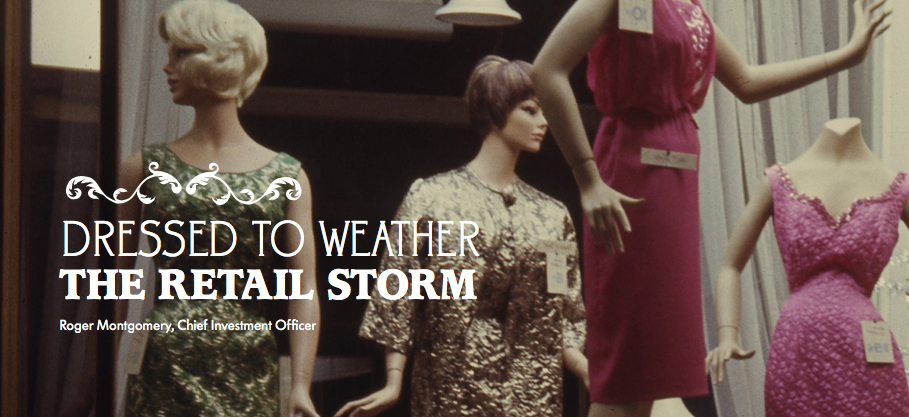Consumer discretionary
-

Is Dick Smith’s float one to watch?
Russell Muldoon
November 20, 2013
Last week’s Freelancer (FLN) IPO marked the 73rd ASX listing this calendar year. We have steadily grown more and more skeptical at the speed many businesses are being brought to market in the pre-Christmas rush. continue…
by Russell Muldoon Posted in Consumer discretionary.
-
Dressed to weather the retail storm
Roger Montgomery
September 1, 2013

Retail is a tricky sector for investors at the moment. But amidst the harsh conditions, there are some glimmers of opportunity. In this article, Roger Montgomery talks about where we are casting our gaze.
It takes nerves of steel to buy small fashion retailers in this market. Weak consumer confidence, sluggish retail sales growth, price discounting and the online sales threat are pounding the sector. But within the carnage are potential opportunities such as Speciality Fashion Group (SFH).
The turnaround play is in the eye of the retail storm. With 892 stores across the Millers, Katies, Crossroads, Autograph, City Chic and La Senza brands, and around 180 million interactions with Australian shoppers each year, SFH is incredibly leveraged to discretionary spending conditions.
Apparel is a tricky business at the best of times; fashion-fickle consumers and seasonal disruptions such as a warmer-than-expected winter can crunch sales. It takes great skill to sell more clothes when so many headwinds conspire to stop consumers spending.
The list of retail problems is long and growing. In the short term, interest-rate cuts are having less effect as consumers remain concerned about job security and prefer to pay down debt (or buy investment properties!) and spend less. Retail sales grew just 0.1 per cent in May, compared with market expectations of 0.3 per cent.
The lead-up to elections is rarely good for retailers and online sales continue to eat into traditional retail sales channels, albeit off a low base. Rampant price discounting has conditioned consumers to expect ever-lower prices for basic items such as cheap clothing, which the likes of K-Mart almost seem to give away.
These trends are taking a heavy toll. One of SFH’s nearest listed rivals, Noni-B, saw its share price tumble this year after reporting deteriorating conditions within and without.
Among large apparel sellers, Target has been a basket case. Parent company Wesfarmers issued a profit warning for its troubled discount store in May, blaming lower sales, shrinking profit margins, excess inventory and a late start to the winter season. Target’s woes put chills through the broader apparel sector as analysts feared higher-than- expected unsold inventory.
The apparel sector, it seems, can’t take a trick this year. The tragic factory collapse in Bangladesh this year, which killed more than 1,000 garment workers, has put the spotlight on Australian importers such as K-Mart, which source garments, directly or indirectly, from third-world countries.
But despite these problems, some, if not many, retail stocks have rallied in 2013. JB Hi-Fi, for example, has a one-year shareholder return of 105 per cent (including dividends) after touching a 52- week low of $8.34. Kathmandu Holdings is up 89 per cent over one year, and Myer Holdings is up 46 per cent.
These are remarkable performances in the context of such a weak retail market. They show how investors can badly misprice stocks when market noise peaks and everybody is focused on backward- looking newspaper headlines rather than looking forward. The market was too negative towards some high-quality retailers in late 2012, and investors, as is their wont, confused price and value.
This was true of SFH when its shares plumbed 47 cents in 2012 at the peak of the retail-gloom hysteria. Following a surprisingly strong interim profit report in February, the company soared to a 52-week high of $1.20 before retreating to a low of 78 cents in the past few months.
SFH was an easy stock to sell in 2012. As retail sales growth slowed, fewer women would buy dresses at its shops, or would seek lower- priced substitutes at the discount department stores, or so the theory went. And SFH has been a volatile, arguably lower-quality retailer at times over the past decade.
It posted a $2.8 million loss in FY12, partly from higher depreciation charges due to a store rationalisation program, did not declare a final dividend, and gave a cautious view of its outlook. But beneath the gloom were good signs of improving operational performance.
Supply-chain enhancements bolstered the company’s gross profit margin, more goods were being sold online, and operating cash flows were higher due to much better management of working capital. Simply put, SFH was rapidly improving the business to combat retail headwinds.
Those initiatives underpinned sharply improved performance in the first half of FY13. Revenue rose 1.3 per cent to $311.1 million on the same half year earlier, net profit soared from $6.1 million to $17.9 million, and basic earnings per share almost tripled to 9.3 cents.
A 62.4 per cent gross margin was the highest in the company’s history, up a whopping 477 basis points over the half. Higher selling prices, lower product and freight costs, and the benefits of investments in moving to a design and direct sourcing model are transforming SFH’s margins, with another 150 basis points in margin gains targeted for the second half of FY13.
Other cost controls also impressed. It limited cost increases to 1.2 per cent for the half despite annual wage inflation of 3 per cent. Lower base rentals on renewed store leases and the exit of underperforming stores helped contain cost increases.
Although it has done an excellent job in becoming more productive and efficient, those gains alone will not drive SFH sharply higher in the next 3-5 years. The company needs to better leverage its great,
under-recognised strength – a database of 7 million customers built over decades.
Notwithstanding the inevitable ‘returns to senders’ and ‘email address not recognised’, the power of this database, and SFH’s retail reach, usually gets scant consideration in analyst reports, even though it is the key to the company’s long-term fortunes. It is not well known that 55 per cent of Australia’s female adult population are on SFH databases, according to SFH figures.
Long-time market watchers will remember the work of Miller’s Retail Group, once a standalone ASX-listed company, in building a huge database of fashion devotees through a “club format” long before the internet made such channels a critical part of retailing.
SFH is doing a much better job mining this database and improving its customer communication and touchpoints. Its email-valid membership, now 2.5 million and rising, is a huge platform to provide targeted marketing offers to deal-hungry consumers.
A strong ‘omnichannel’ distribution platform – across physical stores and online – is critical in retailing these days, and a significant source of sustainable competitive advantage and value for SFH. The challenge now is to turn that database into sharply higher, sustained sales growth.
For all its recent achievements, SFH does not appear to have received the recognition it deserves. Although it has a volatile record, SFH is starting to look like a much more consistent, high- quality company that ticks key boxes for long-term value investors.
It had net cash of $38.6 million on the balance sheet at June 30, 2013 – down from $45.6 million on the balance sheet at December 31, 2012, which was the highest in seven years. The company repaid $6.5 million of debt in the first half, and has no outstanding debt. A 27.9 per cent Return on Equity (ROE) for FY13 also impressed, given the retail malaise.
SFH has plenty of cash for a circa $150-million company (probably too much) and firepower to make acquisitions as the troubled retail sector inevitably throws up opportunities. It has been touted as a takeover target for the fast-growing Cotton On Group, which has a 20 per cent stake and two directors on the SFH board. Cotton On emerged on the SFH register in 2010.
The key question, of course, is does value exist now?
Another interest-rate cut, a stabilisation of the Australian dollar, and the resolution of the Federal election could spur confidence and give cash registers a slightly stronger ring in the next 12 months, and also create more market focus on the retail sector.
But if conditions remain exceedingly tough, as seems likely, SFH has at least shown it has the right formula, management skill and balance sheet to weather the retail storm.
This article was written on 1 September 2013. All share and other prices and movements in prices are to this date.
by Roger Montgomery Posted in Consumer discretionary.
- save this article
- POSTED IN Consumer discretionary
-

Urban Bunnings
Ben MacNevin
May 15, 2013
Travelled overseas recently? Enjoyed the unique little stores that you can’t find at home? Did you also notice the same stores that you see everywhere else? Walking along the most famous streets in London, Singapore, Paris or Ireland you cannot help but notice the world is becoming bland and generic. continue…
by Ben MacNevin Posted in Consumer discretionary.
- save this article
- POSTED IN Consumer discretionary
-

Which retail sectors are in fashion?
Ben MacNevin
April 26, 2013
Colonial First State has just released their quarterly results to March 2013 for their Retail Property Trust. This retail-specific Australian Real Estate Investment Trust (A-REIT) comprises shopping centres, department stores, supermarkets and specialty stores.
continue…by Ben MacNevin Posted in Consumer discretionary, Insightful Insights.
-

Does intellectual property have the value it once had?
Tim Kelley
April 10, 2013

A strong competitive “moat” is one of the features we value in a business. Moats can take many different forms, but one appealing type of moat is that provided by intellectual property, ideally protected by patents.
Companies like Cochlear, Resmed and Codan are good examples of businesses that owe part of their prosperity to technology that provides an edge over competitors. In many cases, this edge has been built and maintained over many years through substantial investments in R&D.
continue…by Tim Kelley Posted in Consumer discretionary, Insightful Insights, Technology & Telecommunications.
-

What is a game changer?
Roger Montgomery
March 20, 2013
Last night I received an unsolicited text message from Vodafone informing that Samsung had just released their Galaxy 4S. Vodafone cooed “it looks like a game changer”. Last week it was Dominos Pizza who insisted that new toppings (toppings others already had) and a square base (competitors already have those too) were ‘game changers’.
The noun Game Changer is being used a little too liberally at the moment, and lest it creep into our vernacular to such a degree that university students use it to describe skipping the train and catching the bus instead, I thought I’d attempt to use photographs to illustrate my understanding of game changers:-
continue…by Roger Montgomery Posted in Consumer discretionary, Insightful Insights, Technology & Telecommunications.
-

Online Retailing
David Buckland
March 14, 2013
As people conduct more and more of their lives online and the world progressively moves towards being “all digital,” the retail industry is undergoing a significant change.
Consumers are increasingly looking for low prices for top quality goods, and online retailers–able to save on the costs of expensive prime rental locations and sales staff–are meeting this demand.
The growing digitalization of media such as music, books and films plays into this need, and together, these factors are helping to redefine the retail landscape.
continue…by David Buckland Posted in Consumer discretionary.
-

Gamechanger?
Roger Montgomery
March 11, 2013
If you are fan of pizza – I am but only the home made variety I grew up with in inner northern Melbourne – you may have seen Domino’s Pizza promoting its “biggest announcement in twenty years”. The social media campaign caught our interest because the company made a $15.4 million net profit for the six months to December 2012 but enjoys a market capitalisation of $800 million. We wanted to know what their “game changer” was going to be. As one Facebook fan wondered, it could be GPS guided pizza missiles.
Dominos have done an amazing job of harnessing the internet and social media to radically change the fast food industry but this campaign backfired badly. Believe it or not, the “Gamechanger”/”biggest announcement in 20 years”, was the release of new toppings and rectangular pizza bases. In a press release at the weekend Dominos announced:
“In the biggest and tastiest announcement in Domino’s 20 year history, Domino’s Pizza have revealed their new Chef’s Best™ Range…
continue…by Roger Montgomery Posted in Consumer discretionary, Insightful Insights.
-
Longing for Liquidity
Ben MacNevin
March 8, 2013
Below is one of the most spectacular half-year financial results we have seen this reporting season.
continue…by Ben MacNevin Posted in Consumer discretionary, Insightful Insights.
-

MEDIA
Retailers and Banks on the rise
Roger Montgomery
March 5, 2013
In discussion with Ross Greenwood on Radio 2GB, Roger highlights the rising prices of Australian Banks and Retail stocks – but that they still aren’t particularly appealing picks to value investors. Listen here.
This program was broadcast on 5 March 2013.
by Roger Montgomery Posted in Consumer discretionary, Radio.
- save this article
- POSTED IN Consumer discretionary, Radio